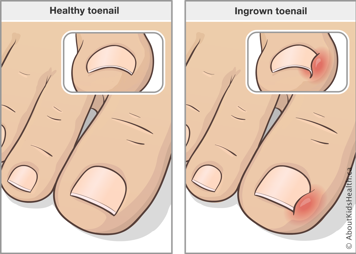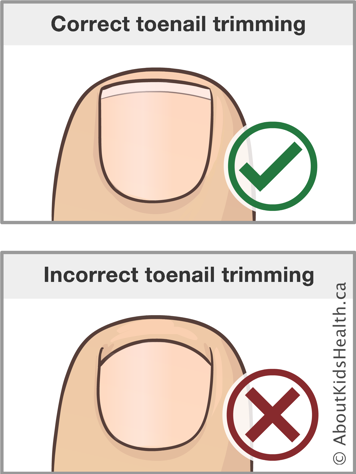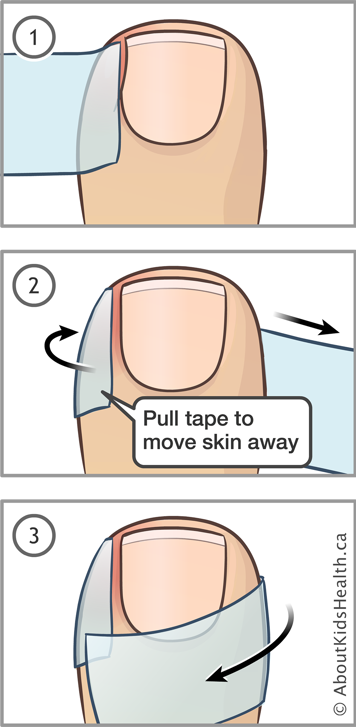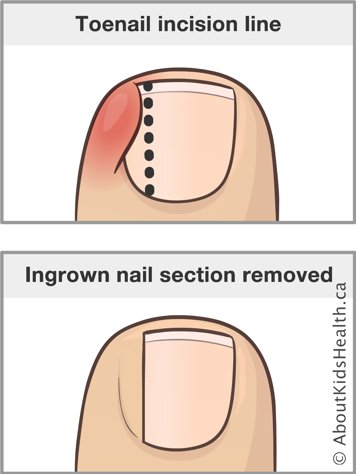What is an ingrown toenail?
An ingrown toenail occurs when the side of the nail grows into the surrounding skin instead of straight outward. Since the nail cuts into the skin, it is common for the area to become infected or inflamed.
Ingrown toenails can cause discomfort and pain. They are a common problem, especially in teenagers and young adults.

How does an ingrown toenail affect the body?
An ingrown toenail is most likely to occur on the big toe, but any toe can be affected.
At first, the skin around the ingrowing nail may become red and feel slightly sore. With time, there can be more pain and swelling. Small openings in the skin can then allow bacteria to enter, which can cause the area to become infected.
What causes an ingrown toenail?
An ingrown toenail can have a number of causes, including:
- poorly fitting shoes
- over-trimming of the nails
- tearing or picking at the nail
- repeated pressure or trauma to the nail
- certain nail or toe shapes
Shoes
Shoes that are too narrow or those that put pressure over the nails are more likely to cause ingrown toenails.
Nail trimming
Trimming the nails too much or rounding the edges instead of cutting straight across can lead to ingrown toenails.

Picking at nails
Ingrown toenails are more likely in children who pick at their toenails.
Pressure or impact on the nail
An ingrown toenail is more likely to occur following a bump or other injury to the toe. For example, people who participate in sports may be more likely to develop ingrown toenails because their feet might be more prone to pressure and injury. The increased sweating that results from physical activity also makes it easier for bacteria to grow and cause an infection.
Nail and toe shapes
Sometimes, deformities of the foot or toes can place extra pressure on the nails. In addition, some people are born with curved nails that grow downward. Others have toenails that are too big for their toes. All of these factors can make ingrown toenails more likely. Some of these conditions may improve on their own over time.
How is an ingrown toenail diagnosed?
A health-care provider can diagnose an ingrown toenail by examining your child and asking questions about how they feel when they walk.
Inspect your child’s feet often to look for any signs of an ingrown toenail. One early sign is redness and swelling of the skin near the edge of the nail. If the ingrown nail is infected, your child may develop a fluid-filled blister or redness that extends around the toe or towards the foot. Your child may also complain that their foot hurts or may limp or wince when they walk.
How is an ingrown toenail treated?

Several options are available to treat an ingrown toenail.
The early signs can be resolved by:
- wearing wider or open-toed footwear
- trimming nails straight across
- finding ways to allow the nail to grow out of the skin, for example by using tape to pull the skin beside the nail out of the way (see image to the right).
Other treatments for ingrown toenails include:
- Soaking the foot in a mix of lukewarm water and mild soap or one to two teaspoons of Epsom salt for 10 to 20 minutes two or three times a day for one to two weeks. After soaking the foot, dry the area and apply a topical antibiotic ointment around the ingrown toenail. During the day, while your child is wearing shoes, the toenail can be covered with a bandage. At night, the bandage can be removed to allow the toenail to "air out" in bed.
- Using a short piece of unflavoured, unwaxed dental floss to gently separate the skin of the toe. Place the floss diagonally under the corner tip of the ingrown nail.
If an infection develops, your child will need to take antibiotics to treat it and prevent complications. In rare cases, your child might need surgery to resolve the problem.

How to treat repeated episodes of ingrown toenail
If your child experiences ingrown toenail repeatedly, they may need surgery to remove part of their nail. This involves a number of steps.
- A local anaesthetic is injected into the base of your child's toe to numb it.
- A health-care provider cuts their toenail the long way (towards the cuticle), just a few millimetres from the problem edge.
- If the nail bed has been exposed a number of times, medication may be applied to help stop the edge of the nail from re-growing and causing another ingrown toenail.
- A bandage is placed over the toe.
You will be told how to care for the area around the nail as it heals.
How can I prevent an ingrown toenail?
There are many ways to prevent an ingrown toenail. Some of these include:
- Nail trimming: Cut your child's toenails straight across so you can see the corners of the nail. Do not round off corners or cut nails too short. After baths or showers, while the nails are still soft, try to bend the toenail corners upward.
- Wearing shoes that fit well: Make sure that your child's shoes are not too narrow or too tight. Shoes that have a wide toe area are the best at preventing the toes from crowding and causing an ingrown toenail.
If my child has an ingrown toenail, is there any way to prevent infection?
Try not to dig out the nail or cut away ingrown skin yourself. "Bathroom surgeries" (over-manipulating the ingrown nail) can cause infections. Stick with gentle treatments described above, including soaking, taping or using clean dental floss.
Infection
If an infection occurs, the skin may become more swollen, red and painful. Some yellow or green pus (fluid) may start oozing from around the nail. The area may also produce a bad smell. Over time, the skin around the nail can overgrow, causing more pain.
If left untreated, an ingrown toenail can lead to cellulitis, a type of skin infection. In extremely rare cases, it can lead to osteomyelitis, an infection of the bone.
When to see a health-care provider for ingrown toenail
See your child’s health-care provider if:
- you have checked your child and noticed early signs of an ingrown toenail but would like a clear diagnosis
- your child’s symptoms continue after you have treated the early signs of an ingrown toenail
- your child complains of pain across the toe
- your child shows signs of infection beside the nail, such as redness, pus or a bad smell
- your child has a fever
References
Schmitt, B. Toenail - Ingrown. American Academy of Pediatrics, Pediatric Patient Education. Retrieved from https://patiented.solutions.aap.org/handout.aspx?gbosid=494554.